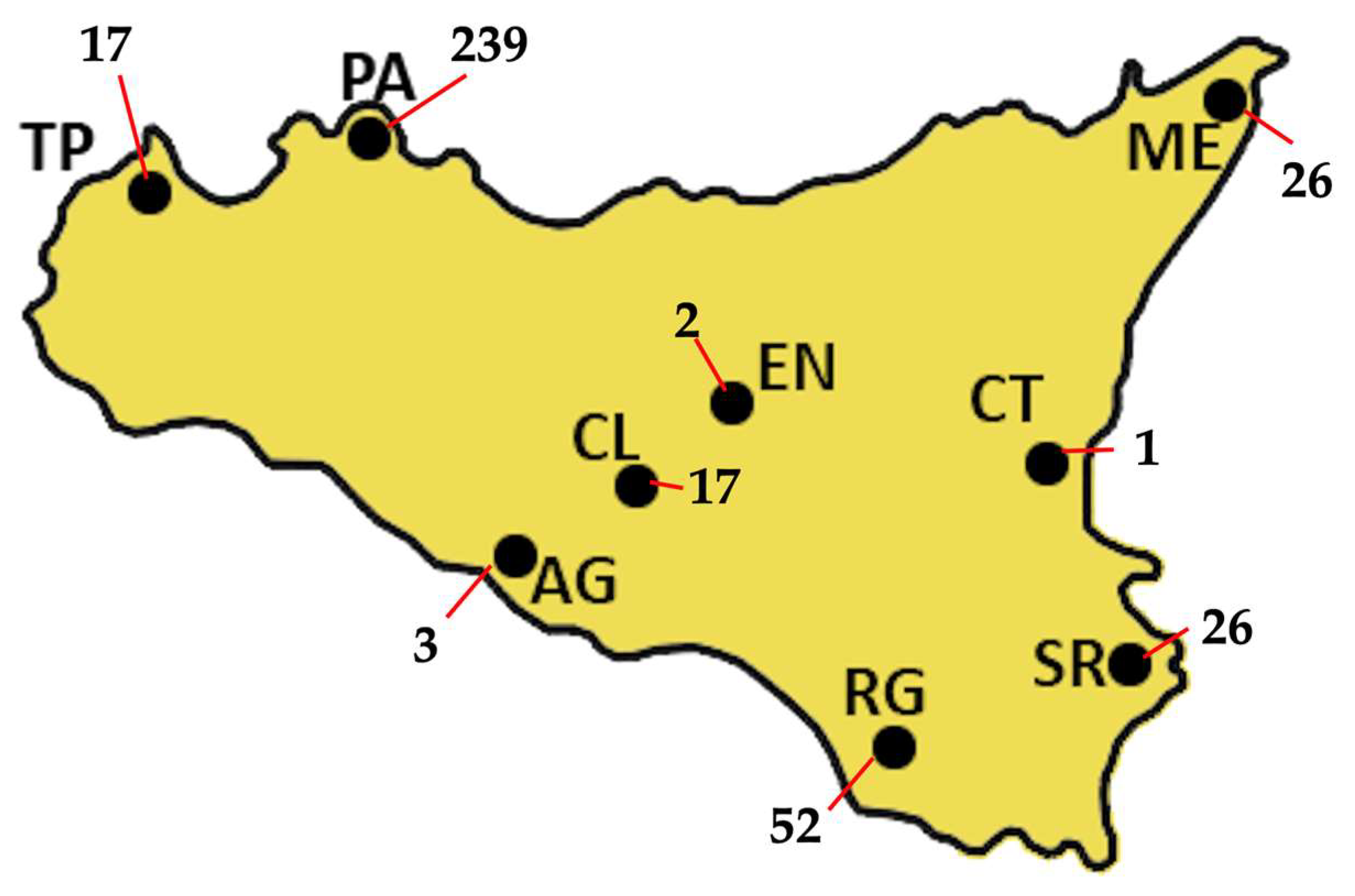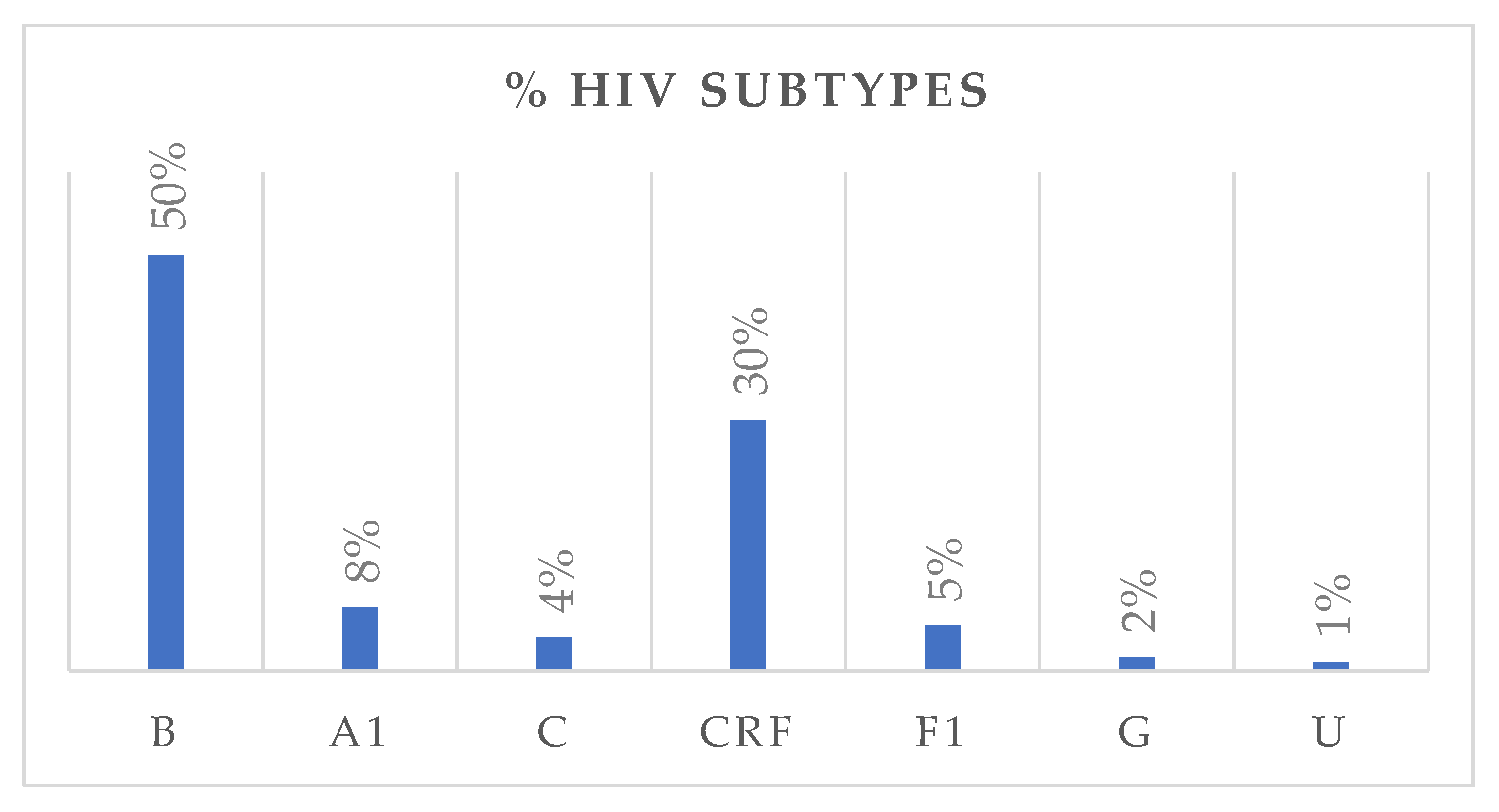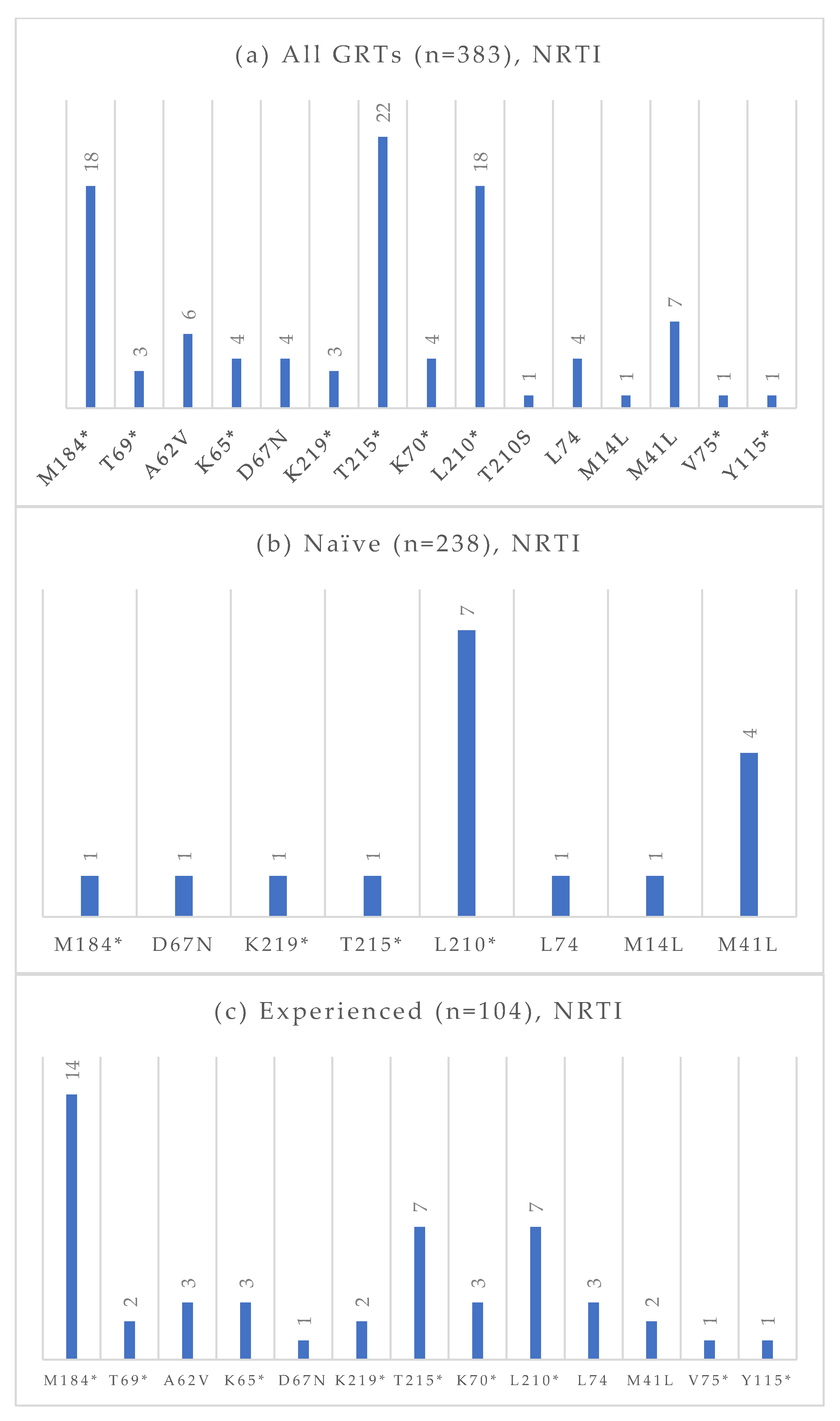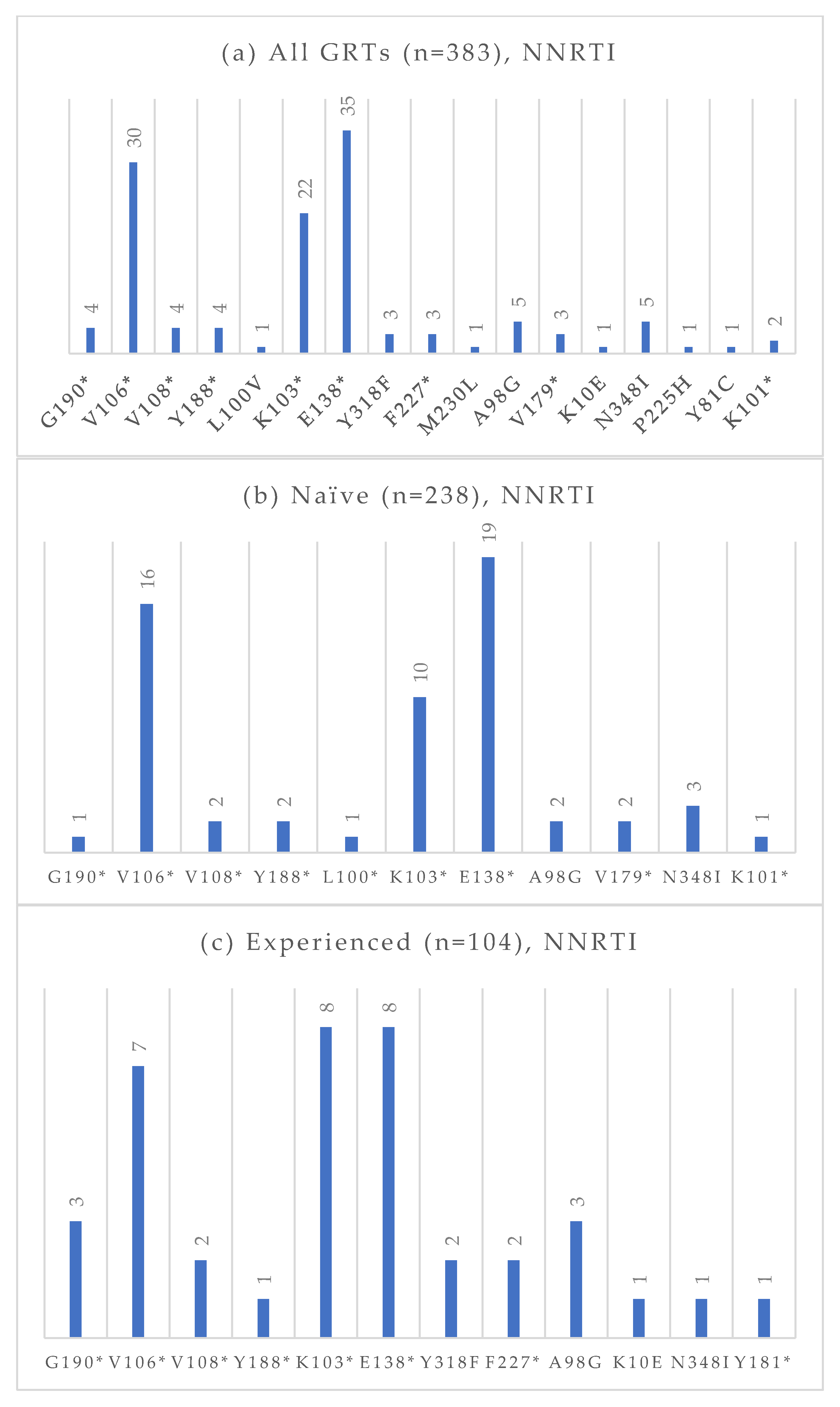Next-Generation Sequencing Analysis for HIV-1 Genotyping and Drug Resistance Mutations Mapping in Sicily, Italy
Abstract
1. Introduction
2. Materials and Methods
3. Results
3.1. Features of PLWH Performing GRT
3.2. HIV Subtypes
3.3. Mutations and Drug Resistance
4. Discussion
5. Conclusions
Author Contributions
Funding
Institutional Review Board Statement
Informed Consent Statement
Data Availability Statement
Acknowledgments
Conflicts of Interest
Abbreviations
| ART | Antiretroviral therapy |
| CRF | Circulating recombinant forms |
| GRT | Genotyping resistance test |
| HIV | Human immunodeficiency virus |
| INI | Integrase strand transfer inhibitor |
| NGS | Next-generation sequencing |
| NRTI | Nucleoside reverse transcriptase inhibitor |
| NNRTI | Non-nucleoside reverse transcriptase inhibitor |
| OR | Odds ratio |
| PI | Protease inhibitor |
| PLWH | People living with HIV |
References
- Anastasia, A.; Mazzucco, W.; Pipitò, L.; Fruscione, S.; Gaudiano, R.; Trizzino, M.; Zarcone, M.; Cascio, A. Malignancies in people living with HIV: A 25-years observational study from a tertiary hospital in Italy. J. Infect. Public Health 2025, 18, 102661. [Google Scholar] [CrossRef]
- Piselli, P.; Tavelli, A.; Cimaglia, C.; Muccini, C.; Bandera, A.; Marchetti, G.C.; Torti, C.; Mazzotta, V.; Pipitò, L.; Caioli, A.; et al. Cancer incidence in people with HIV in Italy: Comparison of the ICONA COHORT with general population data. Int. J. Cancer 2025, 157, 1142–1153. [Google Scholar] [CrossRef]
- Pipitò, L.; Zinna, G.; Trizzino, M.; Gioè, C.; Tolomeo, M.; Di Carlo, P.; Colomba, C.; Gibaldi, L.; Iaria, C.; Almasio, P.; et al. Causes of hospitalization and predictors of in-hospital mortality among people living with HIV in Sicily-Italy between 2010 and 2021. J. Infect. Public Health 2023, 16, 1703–1708. [Google Scholar] [CrossRef]
- EACS Guidelines 2024. Available online: https://eacs.sanfordguide.com (accessed on 22 July 2025).
- De Vito, A.; Bezenchek, A.; Scutari, R.; Colagrossi, L.; Valenti, G.; Bellocchi, M.C.; Pipitò, L.; Ferrara, S.; Malandrin, S.; Tallarita, M.; et al. Assessing the utilization of HIV genotype resistance testing: Insight from Italian Infectious Diseases Units. J. Glob. Antimicrob. Resist. 2025, 42, 1–6. [Google Scholar] [CrossRef]
- Armenia, D.; Carioti, L.; Micheli, V.; Bon, I.; Allice, T.; Bonura, C.; Bruzzone, B.; Bracchitta, F.; Cerutti, F.; Giammanco, G.M.; et al. Comparison of Different HIV-1 Resistance Interpretation Tools for Next-Generation Sequencing in Italy. Viruses 2024, 16, 1422. [Google Scholar] [CrossRef]
- Ávila-Ríos, S.; Parkin, N.; Swanstrom, R.; Paredes, R.; Shafer, R.; Ji, H.; Kantor, R. Next-Generation Sequencing for HIV Drug Resistance Testing: Laboratory, Clinical, and Implementation Considerations. Viruses 2020, 12, 617. [Google Scholar] [CrossRef]
- Behjati, S.; Tarpey, P.S. What is next generation sequencing? Arch. Dis. Child. Educ. Pract. Ed. 2013, 98, 236–238. [Google Scholar] [CrossRef]
- Pipitò, L.; Trizzino, M.; Mascarella, C.; Cannella, S.; Gaudiano, R.; Ganci, I.; D’Alessandro, G.; Romanin, B.; Santoro, M.M.; Giammanco, G.M.; et al. Next-generation sequencing and drug resistance mutations of HIV-1 subtypes in people living with HIV in Sicily, Italy, 2021–2023. J. Glob. Antimicrob. Resist. 2025, 41, 68–76. [Google Scholar] [CrossRef]
- Miranda, M.N.S.; Pingarilho, M.; Pimentel, V.; Martins, M.D.R.O.; Kaiser, R.; Seguin-Devaux, C.; Paredes, R.; Zazzi, M.; Incardona, F.; Abecasis, A.B. Trends of Transmitted and Acquired Drug Resistance in Europe From 1981 to 2019: A Comparison Between the Populations of Late Presenters and Non-late Presenters. Front. Microbiol. 2022, 13, 846943. [Google Scholar] [CrossRef]
- Lai, A.; Franzetti, M.; Bergna, A.; Saladini, F.; Bruzzone, B.; Di Giambenedetto, S.; Di Biagio, A.; Lo Caputo, S.; Santoro, M.M.; Maggiolo, F.; et al. Marked decrease in acquired resistance to antiretrovirals in latest years in Italy. Clin. Microbiol. Infect. 2021, 27, 1038.e1–1038.e6. [Google Scholar] [CrossRef]
- Vannappagari, V.; Ragone, L.; Henegar, C.; van Wyk, J.; Brown, D.; Demarest, J.; Quercia, R.; St Clair, M.; Underwood, M.; Gatell, J.M.; et al. Prevalence of pretreatment and acquired HIV-1 mutations associated with resistance to lamivudine or rilpivirine: A systematic review. Antivir. Ther. 2019, 24, 393–404. [Google Scholar] [CrossRef]
- Muccini, C.; Galli, L.; Sampaolo, M.; Gianotti, N.; Castagna, A.; Canetti, D. Increasing trend of transmitted integrase inhibitor resistance in a cohort of antiretroviral therapy-naive people living with HIV. J. Antimicrob. Chemother. 2023, 78, 1314–1315. [Google Scholar] [CrossRef]
- Bozzi, G.; Fabeni, L.; Abbate, I.; Berno, G.; Muscatello, A.; Taramasso, L.; Fabbiani, M.; Nozza, S.; Tambussi, G.; Rusconi, S.; et al. Non-B subtypes account for a large proportion of clustered primary HIV-1 infections in Italy. Sex. Transm. Infect. 2023, 99, 53–56. [Google Scholar] [CrossRef]
- Calza, L.; Tamburello, M.; Borderi, M.; Colangeli, V.; Testi, D.; Amedeo, A.; Re, M.C.; Bon, I. Prevalence of transmitted drug resistance mutations among newly diagnosed HIV-1-infected patients in a large teaching hospital of the Northern Italy. J. Med. Virol. 2020, 92, 929–931. [Google Scholar] [CrossRef]
- Mazzuti, L.; Melengu, T.; Falasca, F.; Calabretto, M.; Cella, E.; Ciccozzi, M.; Mezzaroma, I.; Iaiani, G.; Spaziante, M.; d’Ettorre, G.; et al. Transmitted drug resistance mutations and trends of HIV-1 subtypes in treatment-naïve patients: A single-centre experience. J. Glob. Antimicrob. Resist. 2020, 20, 298–303. [Google Scholar] [CrossRef]
- Fabeni, L.; Rozera, G.; Berno, G.; Giombini, E.; Gori, C.; Orchi, N.; De Carli, G.; Pittalis, S.; Puro, V.; Pinnetti, C.; et al. Molecular Transmission Dynamics of Primary HIV Infections in Lazio Region, Years 2013–2020. Viruses 2021, 13, 176. [Google Scholar] [CrossRef]
- Maggiorella, M.T.; Sanarico, N.; Brindicci, G.; Monno, L.; Santoro, C.R.; Coppola, N.; Cuomo, N.; Azzurri, A.; Cesario, F.; Luciani, F.; et al. High HIV-1 diversity in immigrants resident in Italy (2008–2017). Sci. Rep. 2020, 10, 3226. [Google Scholar] [CrossRef]
- Fabeni, L.; Armenia, D.; Abbate, I.; Gagliardini, R.; Mazzotta, V.; Bertoli, A.; Gennari, W.; Forbici, F.; Berno, G.; Piermatteo, L.; et al. HIV-1 transmitted drug resistance in newly diagnosed individuals in Italy over the period 2015–21. J. Antimicrob. Chemother. 2024, 79, 2152–2162. [Google Scholar] [CrossRef]
- Modica, S.; Rossetti, B.; Lombardi, F.; Lagi, F.; Maffeo, M.; D’Autilia, R.; Pecorari, M.; Vicenti, I.; Bruzzone, B.; Magnani, G.; et al. Prevalence and determinants of resistance mutations in HIV-1-infected patients exposed to integrase inhibitors in a large Italian cohort. HIV Med. 2019, 20, 137–146. [Google Scholar] [CrossRef]
- Ungaro, R.; Taramasso, L.; Bruzzone, B.; Vicenti, I.; Galli, L.; Borghi, V.; Francisci, D.; Pecorari, M.; Zoncada, A.; Callegaro, A.P.; et al. Prevalence of acquired resistance mutations in a large cohort of perinatally infected HIV-1 patients. Clin. Microbiol. Infect. 2019, 25, 1443–1446. [Google Scholar] [CrossRef]
- Santoro, M.M.; Fornabaio, C.; Malena, M.; Galli, L.; Poli, A.; Menozzi, M.; Zazzi, M.; White, K.L.; Castagna, A. Susceptibility to HIV-1 integrase strand transfer inhibitors (INSTIs) in highly treatment-experienced patients who failed an INSTI-based regimen. Int. J. Antimicrob. Agents 2020, 56, 106027. [Google Scholar] [CrossRef]
- Oliveira, M.; Ibanescu, R.I.; Anstett, K.; Mésplède, T.; Routy, J.P.; Robbins, M.A.; Brenner, B.G.; Montreal Primary HIV (PHI) Cohort Study Group. Selective resistance profiles emerging in patient-derived clinical isolates with cabotegravir, bictegravir, dolutegravir, and elvitegravir. Retrovirology 2018, 15, 56. [Google Scholar] [CrossRef]
- Dow, D.E.; Bartlett, J.A. Dolutegravir, the Second-Generation of Integrase Strand Transfer Inhibitors (INSTIs) for the Treatment of HIV. Infect. Dis. Ther. 2014, 3, 83–102. [Google Scholar] [CrossRef]
- Armenia, D.; Santoro, M.M.; Charpentier, C.; Bertoli, A.; Forbici, F.; Calvez, V.; Descamps, D.; Ceccherini-Silberstein, F.; Marcelin, A.G.; Flandre, P. Evaluation of integrase resistance in individuals who failed a regimen containing dolutegravir in French and Italian clinical settings. J. Antimicrob. Chemother. 2023, 78, 1415–1422. [Google Scholar] [CrossRef]
- Buzon-Martin, L.; Navarro-San Francisco, C.; Fernandez-Regueras, M.; Sanchez-Gomez, L. Integrase strand transfer inhibitor resistance mediated by R263K plus E157Q in a patient with HIV infection treated with bictegravir/tenofovir alafenamide/emtricitabine: Case report and review of the literature. J. Antimicrob. Chemother. 2024, 79, 1153–1156. [Google Scholar] [CrossRef]
- Uno, S.; Gatanaga, H.; Hayashida, T.; Imahashi, M.; Minami, R.; Koga, M.; Samukawa, S.; Watanabe, D.; Fujii, T.; Tateyama, M.; et al. Virological outcomes of various first-line ART regimens in patients harbouring HIV-1 E157Q integrase polymorphism: A multicentre retrospective study. J. Antimicrob. Chemother. 2023, 78, 2859–2868. [Google Scholar] [CrossRef]
- Tzou, P.L.; Rhee, S.Y.; Descamps, D.; Clutter, D.S.; Hare, B.; Mor, O.; Grude, M.; Parkin, N.; Jordan, M.R.; Bertagnolio, S.; et al. Integrase strand transfer inhibitor (INSTI)-resistance mutations for the surveillance of transmitted HIV-1 drug resistance. J. Antimicrob. Chemother. 2020, 75, 170–182. [Google Scholar] [CrossRef]
- Casadellà, M.; van Ham, P.M.; Noguera-Julian, M.; van Kessel, A.; Pou, C.; Hofstra, L.M.; Santos, J.R.; Garcia, F.; Struck, D.; Alexiev, I.; et al. Primary resistance to integrase strand-transfer inhibitors in Europe. J. Antimicrob. Chemother. 2015, 70, 2885–2888. [Google Scholar] [CrossRef]
- Branda, F.; Giovanetti, M.; Sernicola, L.; Farcomeni, S.; Ciccozzi, M.; Borsetti, A. Comprehensive Analysis of HIV-1 Integrase Resistance-Related Mutations in African Countries. Pathogens 2024, 13, 102. [Google Scholar] [CrossRef]
- Sayan, M.; Yildirim, F.S.; Akhan, S.; Karaoglan, I.; Akalin, H. Integrase Strand Transfer Inhibitor (INSTI) Genotypic Resistance Analysis in Treatment-Naive, INSTI Free Antiretroviral-Experienced and INSTI-Experienced Turkish Patients Infected with HIV-1. Curr. HIV Res. 2022, 20, 184–192. [Google Scholar] [CrossRef]
- Jeanfreau, K.; Sharma, S.; Frontini, M.; Khirfan, M.; Clark, R.A. Prevalence of Integrase Strand Inhibitor Resistance (INSTI)in New Orleans, Louisiana, 2012–2013. J. La. State Med. Soc. 2015, 167, 19–20. [Google Scholar] [PubMed]
- Loosli, T.; Hossmann, S.; Ingle, S.M.; Okhai, H.; Kusejko, K.; Mouton, J.; Bellecave, P.; van Sighem, A.; Stecher, M.; d’Arminio Monforte, A.; et al. HIV-1 drug resistance in people on dolutegravir-based antiretroviral therapy: A collaborative cohort analysis. Lancet HIV 2023, 10, e733–e741. [Google Scholar] [CrossRef] [PubMed]
- Chu, C.; Tao, K.; Kouamou, V.; Avalos, A.; Scott, J.; Grant, P.M.; Rhee, S.Y.; McCluskey, S.M.; Jordan, M.R.; Morgan, R.L.; et al. Prevalence of Emergent Dolutegravir Resistance Mutations in People Living with HIV: A Rapid Scoping Review. Viruses 2024, 16, 399. [Google Scholar] [CrossRef]
- Merad, Y.; Mariaggi, A.A.; Karmochkine, M.; Slama, L.; Brière, E.; Launay, O.; Viard, J.P.; Charre, C. Virological success despite archived INSTI drug resistance mutations on INSTI-based antiretroviral regimens. AIDS 2025. [Google Scholar] [CrossRef] [PubMed]









| Mutations | Overall (n = 383) | Naïve (n = 238) | Experienced (n = 104) |
|---|---|---|---|
| NRTI | |||
| M184 * | 18 (4.7%) | 1 (0.4%) | 14 (6.8%) |
| T69 * | 3 (0.8%) | 0 | 2 (1.9%) |
| A62V | 6 (1.6%) | 0 | 3 (2.9%) |
| K65 * | 4 (1.0%) | 0 | 3 (2.9%) |
| D67N | 4 (1.0%) | 1 (0.4%) | 1 (1.0%) |
| K219 * | 3 (0.8%) | 1 (0.4%) | 2 (1.9%) |
| T215 * | 22 (5.7%) | 1 (0.4%) | 7 (6.7%) |
| K70 * | 4 (1.0%) | 0 | 3 (2.9%) |
| L210 * | 18 (4.7%) | 7 (2.9%) | 7 (6.7%) |
| T210S | 1 (0.3%) | 0 | 3 (2.9%) |
| L74 | 4 (1.0%) | 1 (0.4%) | 3 (2.9%) |
| M14L | 1 (0.3%) | 1 (0.4%) | 0 |
| M41L | 7 (1.8%) | 4 (1.7%) | 2 (1.9%) |
| V75 * | 1 (0.3%) | 0 | 1 (1.0%) |
| Y115 * | 1 (0.3%) | 0 | 1 (1.0%) |
| NNRTI | |||
| G190 * | 4 (1.0%) | 1 (0.4%) | 3 (2.9%) |
| V106 * | 30 (7.8%) | 16 (6.7%) | 7 (6.7%) |
| V108 * | 4 (1.0%) | 2 (0.8%) | 2 (1.9%) |
| Y188 * | 4 (1.0%) | 2 (0.8%) | 1 (1.0%) |
| L100V | 1 (0.3%) | 1 (0.4%) | 0 |
| K103 * | 22 (5.7%) | 10 (4.2%) | 8 (7.7%) |
| E138 * | 35 (9.1%) | 19 (8.0%) | 8 (7.7%) |
| Y318F | 3 (0.8%) | 2 (0.8%) | 2 (1.9%) |
| F227 * | 3 (0.8%) | 0 | 2 (1.9%) |
| M230L | 1 (0.3%) | 0 | 0 |
| A98G | 5 (1.3%) | 2 (0.8%) | 3 (2.9%) |
| V179 * | 3 (0.8%) | 2 (0.8%) | 0 |
| K10E | 1 (0.3%) | 0 | 1 (1.0%) |
| N348I | 5 (1.3%) | 3 (1.3%) | 1 (1.0%) |
| P225H | 1 (0.3%) | 0 | 0 |
| Y181 | 0 | 0 | 1 (1.0%) |
| K101 * | 2 (0.5%) | (0.4%) | 0 |
| PI | |||
| L33F | 5 (1.3%) | 1 (0.4%) | 2 (1.9%) |
| M46I | 4 (1.0%) | 1 (0.4%) | 2 (1.9%) |
| I54 * | 4 (1.0%) | 1 (0.4%) | 1 (1.0%) |
| V82 * | 3 (0.8%) | 0 | 1 (1.0%) |
| L90M | 4 (1.0%) | 3 (1.3%) | 1 (1.0%) |
| Q58E | 7 (1.8%) | 5 (2.1%) | 1 (1.0%) |
| K43T | 4 (1.0%) | 3 (1.3%) | 0 |
| K20T | 2 (0.5%) | 1 (0.4%) | 0 |
| I84V | 1 (0.3%) | 0 | 0 |
| L10 * | 4 (1.0%) | 2 (0.8%) | 2 (1.9%) |
| V11I | 2 (0.5%) | 0 | 1 (1.0%) |
| V32 | 3 (0.8%) | 1 (0.4%) | 0 |
| I47V | 3 (0.8%) | 1 (0.4%) | 0 |
| L76V | 2 (0.5%) | 0 | 1 (1.0%) |
| I50V | 1 (0.3%) | 0 | 1 (1.0%) |
| T74P | 2 (0.5%) | 0 | 1 (1.0%) |
| G48V | 1 (0.3%) | 0 | 0 |
| L23I | 1 (0.3%) | 1 (0.4%) | 0 |
| G73 * | 1 (0.3%) | 1 (0.4%) | 0 |
| L90V | 1 (0.3%) | 1 (0.4%) | 0 |
| INI | |||
| N155 * | 4 (1.0%) | 0 | 4 (3.8%) |
| E157Q | 17 (4.4%) | 7 (2.9%) | 8 (7.7%) |
| S230R | 1 (0.3%) | 1 (0.4%) | 0 |
| Y143 * | 5 (1.3%) | 0 | 5 (4.8%) |
| S147 * | 3 (0.8%) | 0 | 3 (2.9%) |
| Q146P | 9 (2.3%) | 1 (0.4%) | 6 (5.8%) |
| G140 * | 4 (1.0%) | 0 | 3 (2.9%) |
| Q148 * | 9 (2.3%) | 2 (0.8%) | 6 (5.8%) |
| L74 * | 3 (0.8%) | 1 (0.4%) | 1 (1.0%) |
| E92Q | 1 (0.3%) | 0 | 1 (1.0%) |
| T97A | 4 (1.0%) | 1 (0.4%) | 2 (1.9%) |
| E138K | 2 (0.5%) | 0 | 2 (1.9%) |
| G149A | 1 (0.3%) | 0 | 1 (1.0%) |
| Q95K | 2 (0.5%) | 0 | 2 (1.9%) |
| H51Y | 1 (0.3%) | 0 | 1 (1.0%) |
Disclaimer/Publisher’s Note: The statements, opinions and data contained in all publications are solely those of the individual author(s) and contributor(s) and not of MDPI and/or the editor(s). MDPI and/or the editor(s) disclaim responsibility for any injury to people or property resulting from any ideas, methods, instructions or products referred to in the content. |
© 2025 by the authors. Licensee MDPI, Basel, Switzerland. This article is an open access article distributed under the terms and conditions of the Creative Commons Attribution (CC BY) license (https://creativecommons.org/licenses/by/4.0/).
Share and Cite
Pipitò, L.; Cannella, S.; Mascarella, C.; Graceffa, D.; Trizzino, M.; Iaria, C.; Colletti, P.; Mazzola, G.; Giammanco, G.M.; Cascio, A.; et al. Next-Generation Sequencing Analysis for HIV-1 Genotyping and Drug Resistance Mutations Mapping in Sicily, Italy. Viruses 2025, 17, 1129. https://doi.org/10.3390/v17081129
Pipitò L, Cannella S, Mascarella C, Graceffa D, Trizzino M, Iaria C, Colletti P, Mazzola G, Giammanco GM, Cascio A, et al. Next-Generation Sequencing Analysis for HIV-1 Genotyping and Drug Resistance Mutations Mapping in Sicily, Italy. Viruses. 2025; 17(8):1129. https://doi.org/10.3390/v17081129
Chicago/Turabian StylePipitò, Luca, Sara Cannella, Chiara Mascarella, Domenico Graceffa, Marcello Trizzino, Chiara Iaria, Pietro Colletti, Giovanni Mazzola, Giovanni M. Giammanco, Antonio Cascio, and et al. 2025. "Next-Generation Sequencing Analysis for HIV-1 Genotyping and Drug Resistance Mutations Mapping in Sicily, Italy" Viruses 17, no. 8: 1129. https://doi.org/10.3390/v17081129
APA StylePipitò, L., Cannella, S., Mascarella, C., Graceffa, D., Trizzino, M., Iaria, C., Colletti, P., Mazzola, G., Giammanco, G. M., Cascio, A., Bonura, C., & Sicilian GRT Working Group. (2025). Next-Generation Sequencing Analysis for HIV-1 Genotyping and Drug Resistance Mutations Mapping in Sicily, Italy. Viruses, 17(8), 1129. https://doi.org/10.3390/v17081129








